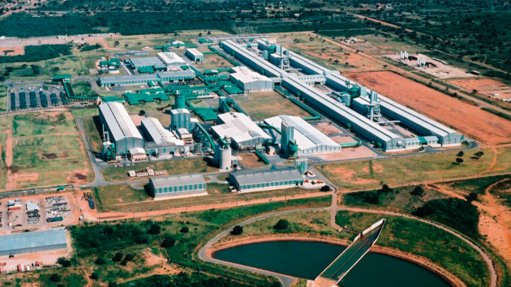Power system stability
Power system stability is the degree to which a power grid continues to supply power after an unexpected event.
An example: the Zambia power system has a demand of about 1 900 MW. Thus, at any one time, generators with a combined capacity of 1 900 MW will be generating into the system, with the power being supplied to consumers. Imagine that lightning strikes one of the power lines connected to a generator and the circuit breakers trip. The remaining generators will be overloaded. In the case of Zambia, most of the power generators are hydroelectric, so the governors of these generators can increase water flow into the hydroelectric turbines to make up the shortfall in power generation. If there is a large loss of generation, then the remaining generators cannot carry the load and the result is that all the remaining generators will slow down and finally trip out on underfrequency when the system frequency falls below 48 Hz (normal is 50 Hz).
The amount of generation power the grid can lose and still supply other loads is called the stability limit. In South Africa, the Eskom grid can lose about 4 500 MW and still be stable. There are many systems in place to ensure power system stability.
Now it is proposed to install a 300 MW solar power system in Zambia as part of the International Finance Corporation’s Scaling Solar initiative. Apart from the fact that the sun goes down at night, in Zambia there is quite a short period of twilight – from beginning of sunset until night. So, at sunset, some nonsolar part of the power generation system will have to pick up the full magnitude of the solar generation in about 30 minutes, which will be at least at a rate of about 6 MW a minute.
The system operators will anticipate this, so they will have generators running that can do this. Currently, the solar power is to be at a single location. But if lightning strikes the power line that is connected to the solar farm, the line will trip and 300 MW of solar power generation will be lost. It will take about 120 seconds for the rest of the power generation system to ramp up. But this will not happen (unless some of the consumer load is tripped) and the net result is that the whole power system will shut down.
In short, adding 300 MW of solar power generation at a single location will render the Zambia power system unstable. In point of fact, the solar system will have to be at a minimum of six different locations, widely separated, for the system to work. The way around this is to have a very big battery that can supply power for about ten minutes and a gas turbine that can start and take load in about 15 minutes. If these are connected to the same power line as the solar power system, they will not be of much use if that line trips; so, they will have to be located elsewhere. Thus, the sizing and location of large solar photovoltaic (PV) systems have to be carefully thought out. Similarly, the gas turbines (which, in Africa, run on diesel, not gas) use a huge amount of fuel, and this has to be stored on site.
Power system instability caused outages in South Australia (in September 2016) and more recently in the UK on August 9. These were largely due to wind farms tripping as a result of weather events, but the same will happen with solar PV generation.
In South Africa, we are not too concerned about the power system being less stable as a result of the connection of renewable-energy systems, since all the renewable-energy generators in this country total no more than 2 500 MW, which is about 6% of the total generation. However, I believe it is a mistake to build large solar PV farms on the scale of hundreds of megawatts. Far better to install 20 MW stations at various locations to supply local mini grids. But time will tell.
Article Enquiry
Email Article
Save Article
Feedback
To advertise email advertising@creamermedia.co.za or click here
Comments
Press Office
Announcements
What's On
Subscribe to improve your user experience...
Option 1 (equivalent of R125 a month):
Receive a weekly copy of Creamer Media's Engineering News & Mining Weekly magazine
(print copy for those in South Africa and e-magazine for those outside of South Africa)
Receive daily email newsletters
Access to full search results
Access archive of magazine back copies
Access to Projects in Progress
Access to ONE Research Report of your choice in PDF format
Option 2 (equivalent of R375 a month):
All benefits from Option 1
PLUS
Access to Creamer Media's Research Channel Africa for ALL Research Reports, in PDF format, on various industrial and mining sectors
including Electricity; Water; Energy Transition; Hydrogen; Roads, Rail and Ports; Coal; Gold; Platinum; Battery Metals; etc.
Already a subscriber?
Forgotten your password?
Receive weekly copy of Creamer Media's Engineering News & Mining Weekly magazine (print copy for those in South Africa and e-magazine for those outside of South Africa)
➕
Recieve daily email newsletters
➕
Access to full search results
➕
Access archive of magazine back copies
➕
Access to Projects in Progress
➕
Access to ONE Research Report of your choice in PDF format
RESEARCH CHANNEL AFRICA
R4500 (equivalent of R375 a month)
SUBSCRIBEAll benefits from Option 1
➕
Access to Creamer Media's Research Channel Africa for ALL Research Reports on various industrial and mining sectors, in PDF format, including on:
Electricity
➕
Water
➕
Energy Transition
➕
Hydrogen
➕
Roads, Rail and Ports
➕
Coal
➕
Gold
➕
Platinum
➕
Battery Metals
➕
etc.
Receive all benefits from Option 1 or Option 2 delivered to numerous people at your company
➕
Multiple User names and Passwords for simultaneous log-ins
➕
Intranet integration access to all in your organisation


















